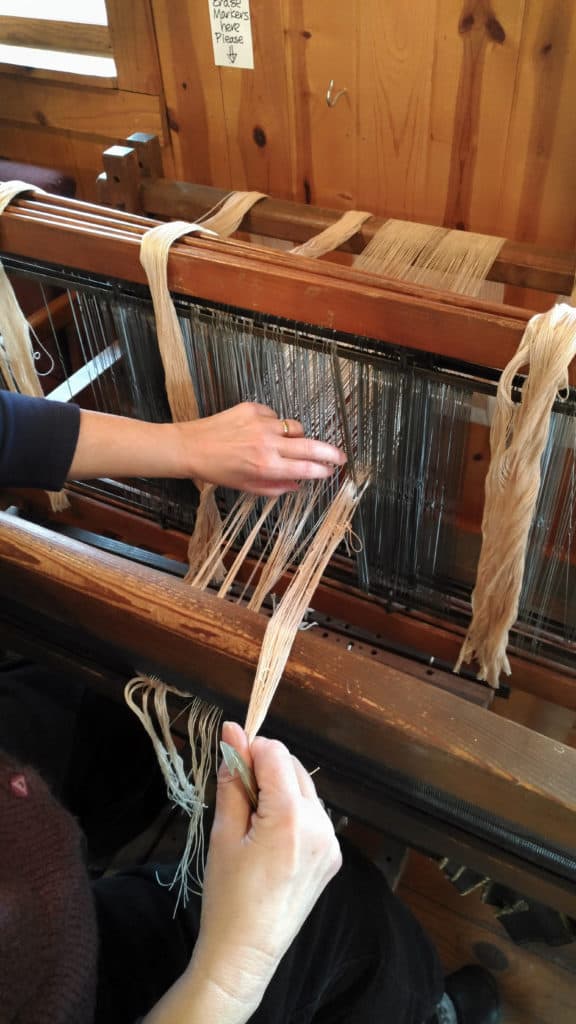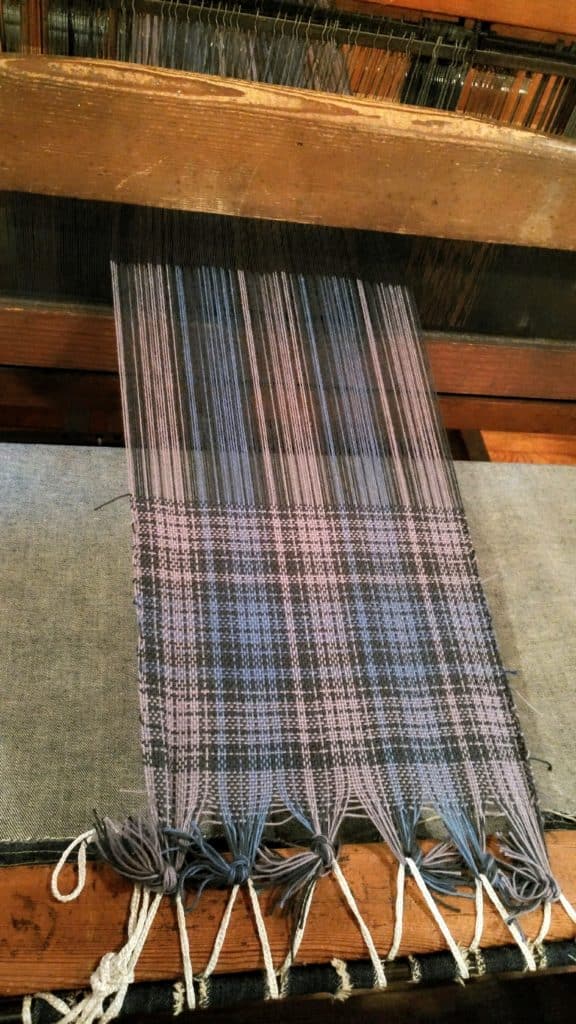Foxfire’s resident weaver and teacher, Sharon Grist, has worked with many looms in her more than forty years of experience in the craft. This week, she sized up an especially curious piece of equipment and explained how it was acquired, speculated on its history, and demonstrated how personal choices can alter the way that weaving patterns emerge.
Last August, a local Clayton couple approached Foxfire looking to rehome an old loom after they’d sold a second house and needed to clear it out. Ten years prior, the loom owner’s husband had bought the piece for her as a surprise gift after seeing it in a local antique shop. According to the shopkeeper, it had made its way there from the John C. Campbell Folk School in nearby Brasstown.
Sharon wondered about that history as she prepared the loom. This long and careful process involves measuring material, threading it through the eyes of heddles, “sleying” the reed, and winding the warp onto the warp beam. These steps help Sharon get familiar with the new-old piece. When she posted an image of it to a website for fiber artists, another user responded that it looked like a model in her possession. “She said that it looked exactly like one she had, which came directly from Berea.” That is Berea College in Kentucky–the revolutionary school founded by abolitionists just five years before the start of the Civil War. By 1883, the school had grown its heritage skills program into “Fireside Industries,” which sold woven products made by students as they learned the art. Berea College was then, as it is now, recognized in Appalachia for both quality education and quality goods. If the loom is truly identical to the Berea model and if Foxfire’s loom really did come from the John C. Campbell Folk School (no marking has been found), then a few questions emerge: Did the folk school make looms similar to Berea College by coincidence? Did they purchase their looms from Berea? Did they use Berea’s plans but construct their own? And importantly, what type of loom is it anyway? The mechanics of this particular machine seem to share elements from both counter-march and counter-balance looms, which made it difficult to classify. After more work with it, Sharon is now confident that it is a counter-balance loom. “It’s like working in genealogy. At some point you might hit a wall until someone else provides more information. So the next step is to talk to the Campbell Folk School and see if we can learn more about its origin. It’s likely that the guts have been rebuilt. That is, the harness system may be newer, but the frame looks original.”
After a few hours, Sharon was able to start weaving. As she pressed the treadles and passed the shuttle across the warp threads, she studied how the loom performed. She wove about a foot of cloth and used the experiment to show how the choice of material and color, texture, and threading sequence all play with the visual effects of a pattern. She followed a classic pattern: log cabin. “Three light, four dark, one light, two dark, three light, one dark, four light, one dark…” she rattles off the steps. While the pattern should turn out the popular log cabin design, it is more akin to a uniform plaid. But this makes for a great teaching moment. Sharon knows that if she had chosen different colors, or if she had used different thread sizes and textures, then the eye may have picked out a different design. The log cabin pattern may have emerged more clearly with other threads.

In the classes Sharon teaches at Foxfire, this is one of the points students learn through exercises that help them see how color choices, textures, and yarn weight all influence how patterns are individualized. As for the loom itself? Sharon says, “It makes for a slower, more intentional weaving experience because of the age and size of the loom compared to modern manufactured looms. It is very smooth and solid and is an absolute delight. It makes me think about the other weavers who have used this loom and wonder about what was woven on it and how many hundred of yards of fabric have come from it through the years.”
To sign up for one of Sharon’s “Beginning Weaving” workshops and meet the newest loom addition, visit https://www.foxfire.org/heritage-skills-classes/
While visiting the Foxfire Museum and Heritage Center, you can also stop by Sharon’s cabin to see her at work (Call ahead to verify availability). Then, walk over to the Savannah House to see the museum’s rare rocker beater loom, which was used during the eighteenth and nineteenth centuries in Southern Appalachia (learn more here). If you’d like to read about every step to weaving in Southern Appalachia, from raising sheep to natural dye and cloth making, see Foxfire 2.

~Chelsea Flowers, Spring Graduate Intern